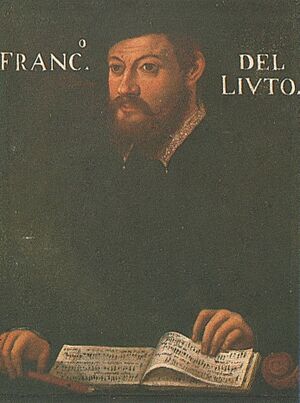Francesco Canova da Milano facts for kids

Francesco Canova da Milano (born August 18, 1497 – died January 2, 1543) was a famous Italian musician. People called him Francesco da Milano or even Il divino (meaning 'the divine one'). He played the lute and wrote music.
He was born in Monza, a city near Milan. For most of his life, he worked for the Pope in Rome. Many people across Europe thought he was the best lute player and composer of his time. We still have more of his music today than from any other lute player from that period. His music even inspired other composers for over 100 years after he died.
Contents
Francesco's Life Story
Francesco was born in Monza, a small city not far from Milan. His father, Benedetto, was a musician. His older brother, Bernardino, was also a musician.
By 1514, Francesco was living in Rome and working for the Pope. He and his father became private musicians for Pope Leo X in 1516. Francesco stayed in this job until the Pope died in 1521.
We don't know much about his next few years in Rome. But in 1526, he and another lute player performed for Pope Clement VII. They also played for Isabella d'Este, a very important lady of that time.
Later Years and Travels
Details about Francesco's later life are not very clear. He might have worked in Paris for a short time. This is why some people called him Francesco da Parigi.
In 1528, he got a special church position in Milan. He later gave this job to his brother. He might have visited Murano in 1530.
Between 1531 and 1535, he worked for a powerful church leader named Cardinal Ippolito de' Medici. In 1535, Francesco became a lute teacher for Ottavio Farnese. Ottavio was the grandson of Pope Paul III.
By 1538, Francesco was working for another important church leader, Cardinal Alessandro Farnese. This cardinal was famous for supporting artists. In July of that year, Francesco married Clara Tizzoni, a noblewoman from Milan. They lived in Milan for a while. By early 1539, Francesco and his father were again working for the Pope.
We don't know much about Francesco's last years or where he died. We only know the exact date of his death, January 2, 1543, from an old book. His brother lived for at least 19 more years after Francesco died. His father probably also lived longer than Francesco.
Francesco's Musical Works
Even by 1530, Francesco's music was well-known and studied. Some of his pieces were printed in France in 1529. Five books of his lute music were published in Milan in 1536. Many old handwritten copies of his music also exist.
Today, we know of over 100 of his pieces called ricercars and fantasias. These two words meant similar things in his time. We also have about 30 intabulations and a few other pieces by him.
His Unique Style
Francesco's music shows a change in lute playing. It moved from a free, improvisational style to more complex music with many different melodic lines playing together. A key part of his style was taking short musical ideas and developing them throughout a piece. He used techniques from vocal music of his time, like the works of Josquin des Prez.
He was also one of the first composers to create monothematic ricercars. This means the whole piece is based on just one main musical idea. Today, Francesco is famous for his ricercars and fantasias. But people in his time thought his intabulations were his best work. Intabulations are pieces he arranged for the lute that were originally sung by singers.
All of Francesco's known lute music was put together in a book in 1970. Each piece in this book has a special "Ness" number, like an Opus number, to help identify it.
The "Canzona" Mystery
There is a famous song called "Canzona by Francesco da Milano." It is also known as "The City of Gold." However, this song was NOT actually written by Francesco da Milano!
It was a musical trick by a lutenist and famous prankster named Vladimir Vavilov. He wrote the tune himself but said Francesco da Milano composed it.
After the rock band Aquarium released the song in 1987, it became a huge hit in the Soviet Union and other countries. People started to wonder who really wrote it. It wasn't until the 2000s that the truth came out. Vavilov was finally given credit for the hit song, even though he had already passed away.

